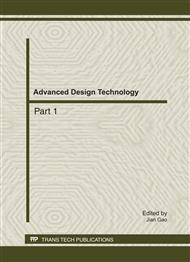[1]
J. Pamela, B. Kaste: Amptiac Newsl Vol. 4 (2004), p.85.
Google Scholar
[2]
S.F. Son, J.R. Busse, B.W. Asay, P.D. Peterson, J.T. Mang, B. Bockmon and M.L. Pantoya: The 29th IPS, 2002, 7.
Google Scholar
[3]
Mingfeng Luo, Lixia Li and Yi Yang: Micro Technol Vol. 05 (2010), p.297.(In Chinese)
Google Scholar
[4]
Xiaojun Zhang, Dongen Zhang, Xiaomin Ni and Huagui Zheng: Solid. State. Electron Vol. 2 (2008), p.245.
Google Scholar
[5]
A. Chowdhuri, V. Gupta, K. Sreenivas, R. Kumar, S. Mozumdar and P.K. Patanjali: Appl. Phys. Lett Vol. (84) (2004), p.1180.
DOI: 10.1063/1.1646760
Google Scholar
[6]
Kebin Zhou, Ruipu Wang, Boqing Xu and Yadong Li: Nanotechnology Vol. 15 (2006), p.3939.
Google Scholar
[7]
J.T. Zhang, J.F. Liu, Q. Peng, X. Wang and Y.D. Li: Chem. Mater Vol. 4 (2006), p.867.
Google Scholar
[8]
M.H. Cao, C.W. Hu and Y.H. Wang: Chem. Commun Vol. 15 (2003), p.1884.
Google Scholar
[9]
Y. Chang, H. C. Zeng: Cryst. Growth. Des Vol. 2 (4) (2004), p.397.
Google Scholar
[10]
X.P. Gao, J.L. Bao, G.L. Pan, H.Y. Zhu, P.X. Huang, F. Wu and D.Y. Song: J. Phys. Chem. B Vol. 18 (108) (2004), p.5547.
Google Scholar
[11]
X.G. Wen, W.X. Zhang and S.H. Yang: Langmuir Vol. 14 (19) (2003), p.5898.
Google Scholar
[12]
H.W. Hou, Y. Xie and Q. Li: Cryst. Growth. Des Vol. 1 (5) (2005), p.201.
Google Scholar
[13]
X.C. Jiang, T. Herricks and Y.N. Xia: Nano. Lett Vol. 12 (2) (2002), p.1333.
Google Scholar
[14]
Y.Y. Xu, D.R. Chen and X.L. Jiao: J. Phys Chem. B Vol. 28 (109) (2005), p.13561.
Google Scholar
[15]
B. Liu, H.C. Zeng: J. Am. Chem. Soc Vol. 26 (126) (2004), p.8124.
Google Scholar
[16]
T. Miao, L. Wang: Tetrahedron. Lett Vol. 48 (2007), p.95.
Google Scholar
[17]
M. Kidwai, N.K. Mishra and V. Bansal: Tetrahedron. Lett Vol. 48 (2007), p.8883.
Google Scholar
[18]
Y.H. Kim, D.K. Lee, B.G. Jo, J.H. Jeong and Y.S. Kang: Colloids. Surf. A-phys. Eng Asp Vol. 284 (2006), p.364.
Google Scholar
[19]
M. Salavati-Niasari, F. Davar and N. Mir: POLYHEDRON Vol. 17 (27) (2008), p.3514.
DOI: 10.1016/j.poly.2008.08.020
Google Scholar
[20]
Xiaowang Liu, Baoyou Geng, Qingbo Du, Jinzhu Ma and Xiangming Liu: Mater. Sci. Eng. A Vol. 1-2 (448) (2008), p.7.
Google Scholar
[21]
S.S. Hayrapetyan, H.G. Khachatryan: Micro. Mesop. Mater Vol. 1-3 (89) (2006), p.33.
Google Scholar
[22]
Wenliang Wang, Dongsheng Li, Zhenping Qin, Kefen Yue and Wenxuan Yang: Chinese J. Catal Vol. 03 (2001), p.301.(In Chinese)
Google Scholar
[23]
S.H. Yu, H.J. Colfen: Mater. Chem Vol. 14 (2004), p.2124.
Google Scholar
[24]
Zhigang Jia, Linhai Yue, Yifan Zheng and Zhude Xu: Chinese J. Inorg. Chem Vol. 07 (2007), p.1277.(In Chinese)
Google Scholar


